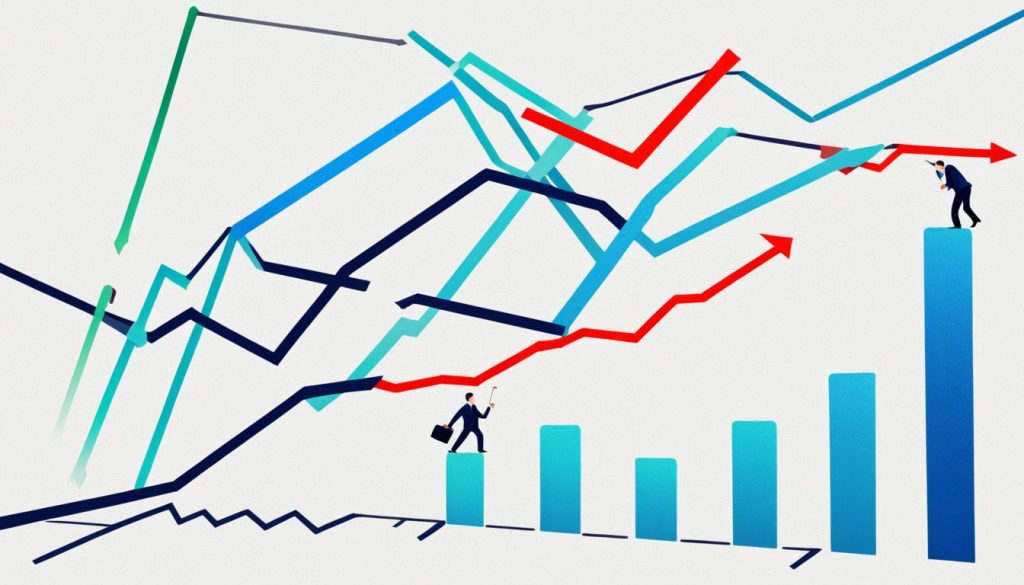For bond investors, knowing about yield to call (YTC) is key. It helps you make better investment choices and manage risks. YTC shows the lowest possible return you can get from a bond that can be called early1. It’s similar to yield to worst (YTW), which looks at the return if you invest for a shorter time1.
This article will explain why YTC matters, how to figure it out, and how it compares to other yields. This will help you move through the bond market with more confidence. It’s useful whether you’re experienced or new to investing. Understanding YTC can really change how you invest.
Key Takeaways
- Yield to call (YTC) is a key metric that shows the lowest possible return on a bond with an early call option.
- Knowing YTC helps you get the most out of your bond investments and reduce risks.
- YTC is often the same as yield to worst (YTW), which looks at the return for a shorter investment period.
- To calculate YTC, you need to think about the bond’s current price, call price, time left until it matures, and coupon rate.
- Comparing YTC to other yield measures, like yield to maturity, gives you important insights for your investment choices.
Understanding Yield to Call (YTC)
What Is Yield to Call?
Yield to call (YTC) is key for investors looking at bonds with call options. It shows the lowest return an investor can get if the bond is called early2. This method gives a safe estimate of the return, helping investors keep their income safe even if things go wrong2.
Bonds with call options let the issuer pay back the bond early, usually when interest rates drop3. YTC assumes the investor holds the bond until it’s called and that it will be called then3. It combines Yield to Maturity (YTM) and Yield to Worst (YTW) to show the worst-case scenario for the investor2.
Knowing YTC is vital for those trading or investing in callable bonds. It helps them see what returns they can expect if they keep the bond until it’s called3. By comparing YTC with YTM and YTW, investors can understand different return possibilities and make smarter choices23.
Understanding yield to call helps investors handle the risks of callable bonds. It ensures their investment goals match the possible returns23.
Importance of Yield to Call in Investment Approach
Yield to call (YTC) is key in your investment strategy, especially when handling a bond portfolio4. It shows the possible return on a callable bond, helping you see the risks and rewards. Knowing YTC lets you make better choices and tailor your bond portfolio to your goals and risk level.
When interest rates drop, the issuer might pay off callable bonds early and refinance at a lower rate4. This shows why YTC matters, as it predicts early redemption and guides your investment moves. On the flip side, when rates go up, calling the bond is less likely4. YTC is then key in managing your risk.
YTC also aids in managing your bond portfolio by balancing risk and return4. Callable bonds usually have a bit more yield to maturity than non-callable ones5. Knowing YTC helps decide if the extra yield is worth the risk of early redemption.
Adding YTC to your investment strategy helps boost your bond portfolio’s yield and control risk4. This is especially useful in unstable markets, where predicting and adapting to interest rate changes can greatly affect your bond investments.
| Metric | Description | Calculation |
|---|---|---|
| Yield to Call (YTC) | The compound interest rate at which the present value of a bond’s future coupon payments and call price is equal to the current market price of the bond. | 4 YTC is calculated as the compound interest rate at which the present value of a bond’s future coupon payments and call price is equal to the current market price of the bond. |
| Yield to Maturity (YTM) | The total return a bond will pay if held until maturity, taking into account the coupon rate, face value, purchase price, and years until maturity. | 5 YTM is calculated as: {Coupon rate + (Face value – Purchase price/years until maturity)} / {Face value + Purchase price/2}. |
“Yield to call is an essential consideration in your investment approach, as it provides a clear understanding of the potential return on a bond with a call provision.”
Calculating Yield to Call
To understand callable bonds, we need to look closely at how to calculate the yield to call (YTC). This metric shows what return an investor might get if a bond is called early6.
The formula for YTC is: YTC = (i + ((Pc – Pm) / n)) / ((Pc + Pm) / 2) × 1006. Here, “i” is the yearly interest, “Pc” is the call price, “Pm” is the market price, and “n” is years until call. This formula helps figure out the yield if the bond is called6.
For example, a bond with a yearly interest of $21, a call price of $150,000, and a market price of $32,000 after 7 years, has a YTC of 18.547%6. This shows how the YTC formula helps us see the possible return on a callable bond.
Callable bonds usually have higher interest rates to draw investors, considering the call risk6. When a bond is called, investors should compare YTC to the yield to maturity (YTM) to decide what to do next – sell or wait until maturity6.
The Mechanics
Understanding YTC calculation involves key factors for investors. The formula looks at coupon interest, call price, market value, and years until call3. This way, it shows the possible return if the bond is called.
For instance, a bond with a $50 coupon, a call price of $1,000, a market value of $950, and 4 years until call, has a YTC of 2.56%3. This assumes the bond won’t be sold early and will be called on time3.
Comparing YTC to YTM and YTW helps investors understand the bond’s possible returns3. YTC looks at returns at call date, YTM at maturity, and YTW at the worst possible yield3. Knowing these yields is key for investors when looking at callable bonds and making choices3.
The YTC calculation also considers the bond’s cash flows if called, affecting the yield7. Adjustments for weekends and holidays, Absolute Yield Spread, Relative Yield Spread, and Yield Ratios further analyze bond yields, giving investors a full view of the bond’s performance7.
Yield to Call vs Yield to Maturity
Understanding the difference between yield to call (YTC) and yield to maturity (YTM) is key for bond investments8. YTM shows the average return if you hold the bond until it matures8. YTC is for bonds that can be called early by the issuer.
YTC looks at the bond’s call price and the time until it can be called8. It assumes the bond will be redeemed early, unlike YTM which assumes it’s held till maturity8. This means YTC has more risk but could offer higher returns if called early8.
Let’s look at how YTC and YTM relate:9 If a bond is discounted, YTC is higher than YTM because the discount is returned faster9. But if a bond is at a premium, YTM is higher than YTC.
Looking at YTC and YTM can help you understand the risks and rewards of a bond10. For example, if a bond has a 4% YTC and a 3.5% YTM, holding it until called could give you a 4% return, better than waiting till maturity for 3.5%10. This knowledge helps you make better investment choices and manage risk.

Factors Affecting Yield Calculations
YTM and bond yields are affected by interest rates, credit risk, and market conditions8. YTM is the total return if held to maturity, based on the bond’s coupon rate, price, and maturity8. The nominal yield is the annual interest divided by the bond’s par value, and the current yield is the annual interest divided by the market price9.
Knowing about YTC and YTM helps you make smart investment choices based on your risk tolerance and goals10. The coupon rate and market price affect YTM, while YTC is key for early redemption possibilities1089.
Yield to Call and Other Yield Measures
Investing in bonds involves looking at yield to call (YTC) and other important measures. Yield measures help investors understand a bond’s potential returns and risks. This knowledge is key to building a diverse and well-managed portfolio11.
Other key yield measures include nominal yield, current yield, and yield to worst. Knowing how these metrics work together helps you see a bond’s performance better. It also helps you choose the right investment strategy11.
YTC shows the yearly return if you buy a bond now and hold it until it’s called11. It might be different from yield to maturity (YTM) because of fees and shorter times11. YTC is usually the same as or more than YTM for bonds selling at a discount. For bonds selling at a premium, it’s the same as or less than YTM11.
Companies use YTC to decide if new bonds are a better deal than their current debt11. If a new bond offers less yield than an existing one, investors might feel let down. To fix this, companies might offer special discounts11.
Callable bonds are a big part of the bond market and make investing more complex12. These bonds can be called in different ways, each affecting their yield12. It’s crucial for investors to know about these call features to make smart choices12.
Looking at various yield measures, like YTC, helps investors understand a bond’s potential. This knowledge is key to building a diverse portfolio that fits their risk level and financial goals1112.
Evaluating Bonds with Yield to Call
When looking at bonds, yield to call (YTC) is key, especially for bonds that can be called early13. These bonds let the issuer pay off the debt early, with a clear schedule13. The issuer usually pays a bit more than face value to call these bonds back13. By comparing YTC to yield to maturity (YTM), you can see how early call might affect the bond’s return and risk13.
This info helps you pick better bonds for your portfolio and improve your bond strategy13. Bonds that can be called early usually have higher yields than those that can’t14. The YTC formula helps find the rate that makes the bond’s present value equal to its current price and the call price13. For example, a bond with a call price of 104, a 8% coupon, and a YTC of 6.7% has an initial price of 10513.
It’s important to compare YTC and YTM to decide if to cash in or hold the bond until it matures13. The lowest possible return, called yield to worst (YTM), shows the risk of early redemption14. If YTC is higher than YTM, there’s a big chance the bond will be called early, affecting your decision14.
Using a yield to call calculator in Excel makes these calculations easier13.

| Metric | Description | Example Value |
|---|---|---|
| Yield to Call (YTC) | The interest rate that sets the present value (PV) of a bond’s scheduled coupon payments and the call price equal to the current bond price. | 6.7% |
| Yield to Maturity (YTM) | The rate of return that would be earned if the bond was held until its maturity date. | 5.4% |
| Yield to Worst (YTW) | The lowest possible return, besides default, used to assess the risk of an issuer redeeming bonds early. | 5.4% |
Understanding yield to call helps investors make better choices when looking at bonds, especially those that can be called early1314.
“Analyzing yield to call is essential for managing risk in a bond portfolio, as it allows investors to anticipate potential early redemptions and adjust their strategies accordingly.”
Understanding Yield Terminology
What Is Yield?
Yield is a key term in investing. It shows the return an investor can get from their money. It matters for understanding bond yield, stock yield, and mutual fund yield. Knowing this helps investors see how well their investments might do15.
Stock yields include the dividends paid to shareholders. This shows the income from the investment. Bond yields are the interest paid to those who buy bonds. Mutual fund yields show the net income of the fund, helping investors see how well the fund is doing15.
It’s important to know how to calculate these yields. This helps investors make smart choices. By understanding bond yield, stock yield, and mutual fund yield, you can see the potential returns and cash flow of your investments. This helps you reach your financial goals15.
| Yield Type | Description | Calculation |
|---|---|---|
| Bond Yield | The annual interest paid to bondholders | Coupon Rate / Current Bond Price |
| Stock Yield | The dividends paid to shareholders | Dividends per Share / Current Stock Price |
| Mutual Fund Yield | The net income generated by the fund | Net Investment Income / Total Net Assets |
Understanding different yields and how they’re calculated helps investors make better choices. This guide explains the criminal justice process for victims. It covers their rights and the roles of law enforcement and prosecutors15.
Conclusion
The yield to call (YTC) is key in your investment plan. It shows the possible returns and risks of callable bonds16. By knowing YTC and comparing it to yield to maturity (YTM) and yield to worst (YTW), you can make better choices. This helps you meet your income needs, even if things go wrong16.
Adding YTC to your investment strategy boosts your confidence in the bond market17. It lets you see the risks and rewards of callable bonds being called early. This helps you get the most out of your investments in today’s fast-paced digital world16.
Using yield to call and other measures like running yield, nominal yield, annual percentage yield (APY), and tax-equivalent yield (TEY) can improve your investment portfolio18. This knowledge helps you make smart choices and manage risks in the bond market161718.
FAQ
What is Yield to Call (YTC)?
Yield to Call (YTC) is the lowest possible return on a bond with an early exit option. It helps investors manage risks. This ensures they meet income needs even in tough times.
Why is Yield to Call an important consideration in investment approach?
Yield to Call shows the best return possible on a bond with a call option. It helps you weigh risks and rewards. This way, you can make better investment choices and improve your bond portfolio.
How is Yield to Call calculated?
The Yield to Call formula includes the coupon interest, call price, market value, and years until call. Knowing how to calculate YTC helps you understand the return potential of a callable bond.
How does Yield to Call differ from Yield to Maturity?
Yield to Maturity (YTM) is the average yearly return if held till maturity. Yield to Call (YTC) is the lowest possible return if called early. Comparing YTC and YTM offers insights into bond risks and returns.
What other yield measures should investors consider?
Investors should look at nominal yield, current yield, and yield to worst too. These measures give more info on a bond’s returns and risks. Knowing these can help diversify and manage risk in your bond portfolio.
Why is it important to evaluate bonds with Yield to Call?
Evaluating YTC and comparing it with YTM helps assess a bond’s call feature impact. This info aids in making informed investment choices. It helps optimize your bond strategy.
What is the definition of yield?
Yield shows an investment’s return, usually as a percentage. For stocks, it’s dividends paid to shareholders. For bonds, it’s the interest paid to holders. Mutual fund yield is the net income earned by the fund.

